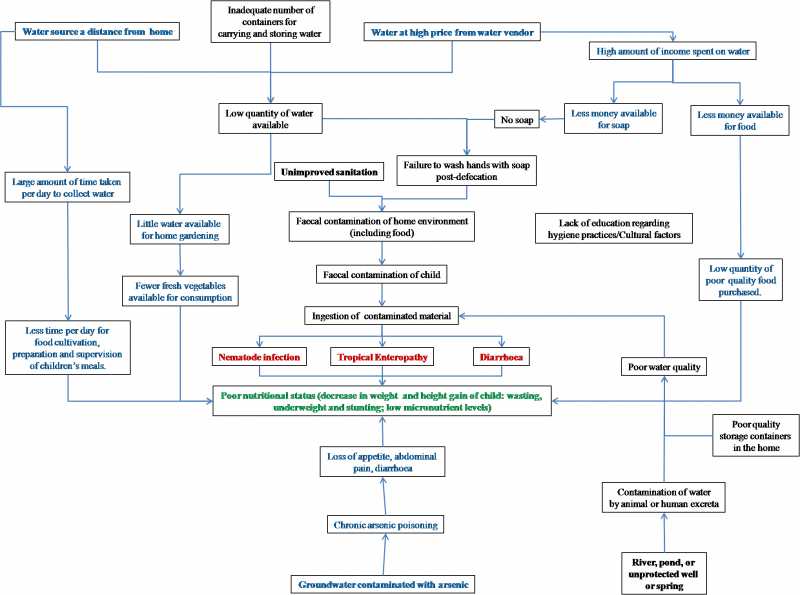- Health and hygiene, schools and other non-household settings
- Nutrition and WASH (including stunted growth)
- Research on WASH & Nutrition, including environmental enteropathy
- Resources on WASH and undernutrition link... and your views and contributions!
Resources on WASH and undernutrition link... and your views and contributions!
37.8k views
- aloefan
-
Less
- Posts: 5
- Likes received: 4
- campbelldb
-

- A WASH Communications/Knowledge Management professional with 30 plus years of experience.
Less- Posts: 316
- Karma: 13
- Likes received: 83
Re: Lancet Global Health survey of anaemia in women and children
Global, regional, and national trends in haemoglobin concentration and prevalence of total and severe anaemia in children and pregnant and non-pregnant women for 1995–2011: a systematic analysis of population-representative data. Lancet Global Health, July 2013.
Full text: download.thelancet.com/pdfs/journals/lan...2214109X13700019.pdf
Gretchen A Stevens, Mariel M Finucane, Luz Maria De-Regil, Christopher J Paciorek, Seth R Flaxman, Francesco Branca, Juan Pablo Peña-Rosas, Zulfi qar A Bhutta, Majid Ezzati, on behalf of Nutrition Impact Model Study Group (Anaemia)
Background - Low haemoglobin concentrations and anaemia are important risk factors for the health and development of women and children. We estimated trends in the distributions of haemoglobin concentration and in the prevalence of anaemia and severe anaemia in young children and pregnant and non-pregnant women between 1995 and 2011.
Methods - We obtained data about haemoglobin and anaemia for children aged 6–59 months and women of childbearing age (15–49 years) from 257 population-representative data sources from 107 countries worldwide. We used health, nutrition, and household surveys; summary statistics from WHO’s Vitamin and Mineral Nutrition Information System; and summary statistics reported by other national and international agencies. We used a Bayesian hierarchical mixture model to estimate haemoglobin distributions and systematically addressed missing data, non-linear time trends, and representativeness of data sources. We quantifi ed the uncertainty of our estimates.
Findings - Global mean haemoglobin improved slightly between 1995 and 2011, from 125 g/L (95% credibility interval 123–126) to 126 g/L (124–128) in non-pregnant women, from 112 g/L (111–113) to 114 g/L (112–116) in pregnant women, and from 109 g/L (107–111) to 111 g/L (110–113) in children. Anaemia prevalence decreased from 33% (29–37) to 29% (24–35) in non-pregnant women, from 43% (39–47) to 38% (34–43) in pregnant women, and from 47% (43–51) to 43% (38–47) in children. These prevalences translated to 496 million (409–595 million) non-pregnant women, 32 million (28–36 million) pregnant women, and 273 million (242–304 million) children with anaemia in 2011. In 2011, concentrations of mean haemoglobin were lowest and anaemia prevalence was highest in south Asia and central and west Africa.
Interpretation - Children’s and women’s haemoglobin statuses improved in some regions where concentrations had been low in the 1990s, leading to a modest global increase in mean haemoglobin and a reduction in anaemia prevalence. Further improvements are needed in some regions, particularly south Asia and central and west Africa, to improve the health of women and children and achieve global targets for reducing anaemia.
Full text: download.thelancet.com/pdfs/journals/lan...2214109X13700019.pdf
Gretchen A Stevens, Mariel M Finucane, Luz Maria De-Regil, Christopher J Paciorek, Seth R Flaxman, Francesco Branca, Juan Pablo Peña-Rosas, Zulfi qar A Bhutta, Majid Ezzati, on behalf of Nutrition Impact Model Study Group (Anaemia)
Background - Low haemoglobin concentrations and anaemia are important risk factors for the health and development of women and children. We estimated trends in the distributions of haemoglobin concentration and in the prevalence of anaemia and severe anaemia in young children and pregnant and non-pregnant women between 1995 and 2011.
Methods - We obtained data about haemoglobin and anaemia for children aged 6–59 months and women of childbearing age (15–49 years) from 257 population-representative data sources from 107 countries worldwide. We used health, nutrition, and household surveys; summary statistics from WHO’s Vitamin and Mineral Nutrition Information System; and summary statistics reported by other national and international agencies. We used a Bayesian hierarchical mixture model to estimate haemoglobin distributions and systematically addressed missing data, non-linear time trends, and representativeness of data sources. We quantifi ed the uncertainty of our estimates.
Findings - Global mean haemoglobin improved slightly between 1995 and 2011, from 125 g/L (95% credibility interval 123–126) to 126 g/L (124–128) in non-pregnant women, from 112 g/L (111–113) to 114 g/L (112–116) in pregnant women, and from 109 g/L (107–111) to 111 g/L (110–113) in children. Anaemia prevalence decreased from 33% (29–37) to 29% (24–35) in non-pregnant women, from 43% (39–47) to 38% (34–43) in pregnant women, and from 47% (43–51) to 43% (38–47) in children. These prevalences translated to 496 million (409–595 million) non-pregnant women, 32 million (28–36 million) pregnant women, and 273 million (242–304 million) children with anaemia in 2011. In 2011, concentrations of mean haemoglobin were lowest and anaemia prevalence was highest in south Asia and central and west Africa.
Interpretation - Children’s and women’s haemoglobin statuses improved in some regions where concentrations had been low in the 1990s, leading to a modest global increase in mean haemoglobin and a reduction in anaemia prevalence. Further improvements are needed in some regions, particularly south Asia and central and west Africa, to improve the health of women and children and achieve global targets for reducing anaemia.
Dan Campbell,
Communications/KM Specialist
Banjo Player/Busker
Haiku poet
Communications/KM Specialist
Banjo Player/Busker
Haiku poet
Please Log in to join the conversation.
You need to login to reply- campbelldb
-

- A WASH Communications/Knowledge Management professional with 30 plus years of experience.
Less- Posts: 316
- Karma: 13
- Likes received: 83
Re: Resources on WASH and undernutrition link... and your views and contributions!
Here is a title listing of some of the reports and studies in the Resource Library: usaidlearninglab.org/working-group/55/resource
You are welcome to download or contribute to the library but an account must fist be set up on the Learning Lab.
Integrating Water, Sanitation and Hygiene into Nutrition Programming. WASHplus
Sanitation and Stunting in India Undernutrition’s Blind Spot . Chambers
Improving WASH Practices and Decreasing Underweight through Care Groups
Does Village Water Supply Affect Children’s Length of Stay in a Therapeutic Feeding Program in Niger?
The Impact of Irrigation on Nutrition, Health, and Gender: A Review Paper with - -
International Food Symptomatic and Asymptomatic Campylobacter Infections Associated with
Reduced Growth in Peruvian Children. PLoS Negl Trop Dis 7(1) 2013. Lee G, et al.
Environmental Enteropathy: Going Beyond Nutrition to Understand Child Growth and Development
The Case for Including the “Neglected Enteric Protozoa" (NEP) and Other Enteropathy-Associated Pathogens in the NTDs. L Bartelt, et al.
USAID Water and Development Strategy 2013-2018.
UNICEF/Ethiopia – Nutrition in Early Childhood: Insights from rural Ethiopia
Determinants of reduced child stunting in Cambodia: analysis of pooled data from three Demographic and Health Surveys-WHO Bulletin
Review: Enteropathies in the Developing World: Neglected Effects on Global Health. A. Prendergast.
How much international variation in child height can sanitation explain? Dean Spears
Alive & Thrive: Early child growth: how do nutrition and infection interact?
Risk assessment of aflatoxins in food in Africa, 2008. Gordon Shephard
LSHTM – Water, Sanitation and Hygiene (WASH), nutrition and infection
“Barriers” to Child Development and Human Potential: The Case for Including the
“Neglected Enteric Protozoa” (NEP) and Other Enteropathy-Associated Pathogens in the NTDs. PLoS Negl Trop Dis, April 2013.Bartelt LA, Lima AAM,...
You are welcome to download or contribute to the library but an account must fist be set up on the Learning Lab.
Integrating Water, Sanitation and Hygiene into Nutrition Programming. WASHplus
Sanitation and Stunting in India Undernutrition’s Blind Spot . Chambers
Improving WASH Practices and Decreasing Underweight through Care Groups
Does Village Water Supply Affect Children’s Length of Stay in a Therapeutic Feeding Program in Niger?
The Impact of Irrigation on Nutrition, Health, and Gender: A Review Paper with - -
International Food Symptomatic and Asymptomatic Campylobacter Infections Associated with
Reduced Growth in Peruvian Children. PLoS Negl Trop Dis 7(1) 2013. Lee G, et al.
Environmental Enteropathy: Going Beyond Nutrition to Understand Child Growth and Development
The Case for Including the “Neglected Enteric Protozoa" (NEP) and Other Enteropathy-Associated Pathogens in the NTDs. L Bartelt, et al.
USAID Water and Development Strategy 2013-2018.
UNICEF/Ethiopia – Nutrition in Early Childhood: Insights from rural Ethiopia
Determinants of reduced child stunting in Cambodia: analysis of pooled data from three Demographic and Health Surveys-WHO Bulletin
Review: Enteropathies in the Developing World: Neglected Effects on Global Health. A. Prendergast.
How much international variation in child height can sanitation explain? Dean Spears
Alive & Thrive: Early child growth: how do nutrition and infection interact?
Risk assessment of aflatoxins in food in Africa, 2008. Gordon Shephard
LSHTM – Water, Sanitation and Hygiene (WASH), nutrition and infection
“Barriers” to Child Development and Human Potential: The Case for Including the
“Neglected Enteric Protozoa” (NEP) and Other Enteropathy-Associated Pathogens in the NTDs. PLoS Negl Trop Dis, April 2013.Bartelt LA, Lima AAM,...
Dan Campbell,
Communications/KM Specialist
Banjo Player/Busker
Haiku poet
Communications/KM Specialist
Banjo Player/Busker
Haiku poet
Please Log in to join the conversation.
You need to login to reply- campbelldb
-

- A WASH Communications/Knowledge Management professional with 30 plus years of experience.
Less- Posts: 316
- Karma: 13
- Likes received: 83
WASH & Nutrition Integration
Integrating Water, Sanitation, and Hygiene into Nutrition Programming, 2013.
www.washplus.org/sites/default/files/wash_nutrition2013.pdf
Diarrhea, pneumonia and birth complications are the top three killers of children under age 5 worldwide. Diarrhea is also a leading cause of undernutrition in this age group and one-third to one-half of all child mortality cases are linked to undernutrition. If mothers and other caregivers used basic hygiene practices and had better access to safe water and adequate sanitation this could greatly reduce under 5 deaths and improve child nutrition.
Integrating Water, Sanitation, and Hygiene into Nutrition Programming, 2013.
www.washplus.org/sites/default/files/wash_nutrition2013.pdf
Diarrhea, pneumonia and birth complications are the top three killers of children under age 5 worldwide. Diarrhea is also a leading cause of undernutrition in this age group and one-third to one-half of all child mortality cases are linked to undernutrition. If mothers and other caregivers used basic hygiene practices and had better access to safe water and adequate sanitation this could greatly reduce under 5 deaths and improve child nutrition.
Dan Campbell,
Communications/KM Specialist
Banjo Player/Busker
Haiku poet
Communications/KM Specialist
Banjo Player/Busker
Haiku poet
The following user(s) like this post: aloefan
Please Log in to join the conversation.
You need to login to replyRe: Resources on WASH and undernutrition link... and your views and contributions!
Dear all,
Please find usefull link on WASH and Nutrition :
xa.yimg.com/kq/groups/15108331/438551712...d+malnutrition...pdf
www.worldwewant2015.org/node/306100
onlinelibrary.wiley.com/doi/10.1002/14651858.CD009382/abstract
Terre des hommes is working on malnutrition since long time. WASH is also part of our response first at health facilities level and then at community level.
We are very much interested by the experiences shared and new publication in this topic and we will support the working group as much as we can.
Best regards
Antoine Delepière
Conseiller Eau Assainissement Hygiène
WASH Adviser
Siège | Hauptsitz | Sede | Headquarters
Avenue de Montchoisi 15, CH-1006 Lausanne | Suisse
Direct + 41 58 611 06 74 | Réception + 41 58 611 06 66,
> Email : This email address is being protected from spambots. You need JavaScript enabled to view it. |skype : ade_tdh.ch | www.tdh.ch
Please find usefull link on WASH and Nutrition :
xa.yimg.com/kq/groups/15108331/438551712...d+malnutrition...pdf
www.worldwewant2015.org/node/306100
onlinelibrary.wiley.com/doi/10.1002/14651858.CD009382/abstract
Terre des hommes is working on malnutrition since long time. WASH is also part of our response first at health facilities level and then at community level.
We are very much interested by the experiences shared and new publication in this topic and we will support the working group as much as we can.
Best regards
Antoine Delepière
Conseiller Eau Assainissement Hygiène
WASH Adviser
Siège | Hauptsitz | Sede | Headquarters
Avenue de Montchoisi 15, CH-1006 Lausanne | Suisse
Direct + 41 58 611 06 74 | Réception + 41 58 611 06 66,
> Email : This email address is being protected from spambots. You need JavaScript enabled to view it. |skype : ade_tdh.ch | www.tdh.ch
Antoine Delepière
WASH Adviser
Terre des hommes
Siège | Hauptsitz | Sede | Headquarters
Avenue de Montchoisi 15, CH-1006 Lausanne | Suisse
Direct + 41 58 611 06 74 | Réception + 41 58 611 06 66,
> Email : This email address is being protected from spambots. You need JavaScript enabled to view it. |skype : ade_tdh.ch | www.tdh.ch
WASH Adviser
Terre des hommes
Siège | Hauptsitz | Sede | Headquarters
Avenue de Montchoisi 15, CH-1006 Lausanne | Suisse
Direct + 41 58 611 06 74 | Réception + 41 58 611 06 66,
> Email : This email address is being protected from spambots. You need JavaScript enabled to view it. |skype : ade_tdh.ch | www.tdh.ch
Attachments:
-
 Conceptual...ork2.jpg
(Filesize: 64KB)
Conceptual...ork2.jpg
(Filesize: 64KB)
-
 Conceptual...work.jpg
(Filesize: 49KB)
Conceptual...work.jpg
(Filesize: 49KB)
The following user(s) like this post: tmsinnovation, aloefan
Please Log in to join the conversation.
You need to login to reply- Petra
-
 Topic Author
Topic Author- Co-founder and former staff member of the CLTS Knowledge Hub (now Sanitation Learning Hub) at IDS, now consultant with 14 years' experience of knowledge management, participatory workshop facilitation, communications and networking. Interested in behaviour change, climate justice and embodied leadership
Less- Posts: 110
- Karma: 8
- Likes received: 27
Resources on WASH and undernutrition link... and your views and contributions!
Dear all, I just wanted to draw your attention to a variety of resources on the CLTS website that are relevant to this topic... My colleague Robert (Chambers) has written several blog and other reflection pieces on the subject of the links between WASH and undernutrition/tropical enteropathy/stunting etc and we have engaged with a variety of people on this subject. You can find some relevant resources here
www.communityledtotalsanitation.org/search/site/nutrition
We are als very interested in hearing from others on the subject matter- so if you have relevant resources or research to share or would like to write a blog, case study etc on the matter, please get in touch This email address is being protected from spambots. You need JavaScript enabled to view it. You are also welcome to add our views to the existing blogs by leaving a comment and starting a discussion.
Best wishes,
Petra
www.communityledtotalsanitation.org/search/site/nutrition
We are als very interested in hearing from others on the subject matter- so if you have relevant resources or research to share or would like to write a blog, case study etc on the matter, please get in touch This email address is being protected from spambots. You need JavaScript enabled to view it. You are also welcome to add our views to the existing blogs by leaving a comment and starting a discussion.
Best wishes,
Petra
Petra Bongartz
independent consultant
independent consultant
The following user(s) like this post: tmsinnovation
Please Log in to join the conversation.
You need to login to reply
Share this thread:
- Health and hygiene, schools and other non-household settings
- Nutrition and WASH (including stunted growth)
- Research on WASH & Nutrition, including environmental enteropathy
- Resources on WASH and undernutrition link... and your views and contributions!
Time to create page: 0.101 seconds







